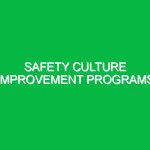In the fast-evolving landscape of workplace safety, the integration of technology has become a cornerstone for ensuring the health and well-being of employees. Workplace Safety Technology Trends refer to the innovative tools and practices that organizations adopt to enhance safety protocols, reduce risks, and foster a culture of safety within their operations. With the ongoing challenges posed by dynamic work environments, especially in sectors like construction, manufacturing, and healthcare, understanding these trends is crucial for business leaders, safety officers, and employees alike.
The Relevance of Technology in Workplace Safety
As we navigate through an era marked by rapid technological advancements, the relevance of these trends in the Health, Safety, and Environment (HSE) domain cannot be overstated. A study by the National Safety Council revealed that nearly 4,100 workplace fatalities occurred in the United States in 2020 alone. Such statistics underscore the urgent need for effective safety measures, enhanced by technology. From wearable safety devices to advanced data analytics, technology offers unprecedented opportunities to mitigate risks and ensure compliance with safety regulations.
Identifying Hazards and Risks in the Workplace
Understanding the potential hazards associated with workplace safety technology is essential for effective risk management. The integration of new technologies, while beneficial, can introduce unique risks. Here are some of the key hazards linked with Workplace Safety Technology Trends:
1. Data Security Risks
As workplaces increasingly rely on digital tools and platforms, the risk of data breaches becomes a pressing concern. Sensitive employee information, safety data, and operational procedures can be compromised if not adequately protected. A notable incident involved a large manufacturing firm that faced a cyberattack, resulting in the exposure of employee health records. This incident illustrates the critical need for robust cybersecurity measures.
2. Human Factors and Technology Overdependence
While technology can enhance safety, an overdependence can lead to complacency. Employees might neglect basic safety protocols, assuming that technology will take care of everything. A construction site in Denver experienced an increase in accidents after implementing a new drone surveillance system. Workers became less vigilant, relying solely on the technology to identify hazards, which led to several near-misses. Training and awareness are essential to counteract this risk.
3. Equipment Malfunction
Smart safety equipment, such as wearable devices and automated machinery, can fail or malfunction, potentially leading to serious accidents. A case study from a petrochemical facility highlighted an incident where a malfunctioning gas leak detector failed to alert workers, resulting in a hazardous exposure situation. Regular maintenance and testing of safety equipment are vital to mitigate such risks.
4. Integration Challenges
The implementation of new safety technologies may encounter resistance from employees or require significant adjustments to existing workflows. A manufacturing plant that introduced a new safety management system faced backlash from workers who found the system complicated. This resistance not only hindered the adoption of the technology but also affected overall safety compliance.
Best Practices and Precautions for Mitigating Risks
To effectively leverage Workplace Safety Technology Trends while minimizing associated risks, organizations can adopt several best practices:
1. Comprehensive Training Programs
Developing robust training programs for employees is essential. Workers should be educated not only on how to use safety technologies but also on the importance of traditional safety practices. A leading auto manufacturer successfully integrated a new machine safety technology by implementing a series of hands-on training sessions, which significantly improved employee engagement and compliance.
2. Regular Equipment Maintenance
Establishing a routine maintenance schedule for safety equipment is crucial. Businesses should conduct regular audits and checks to ensure that all devices function correctly. One construction company adopted a proactive maintenance strategy, reducing equipment failures by 30% over a year.
3. Enhancing Cybersecurity Measures
Organizations must prioritize cybersecurity to protect sensitive data. This includes implementing firewalls, encryption, and employee training on recognizing phishing attempts. A healthcare provider that experienced a data breach strengthened its cybersecurity framework, resulting in a 50% reduction in attempted cyberattacks within six months.
4. Encouraging a Safety Culture
Fostering a culture of safety is perhaps the most effective way to mitigate risks. This involves encouraging open communication about safety concerns and recognizing employees who actively contribute to safety initiatives. A logistics company saw a dramatic decrease in incident reports after launching a safety recognition program that rewarded teams for maintaining accident-free records.
Regulations and Standards Governing Workplace Safety Technology
Workplace safety is governed by various regulations and standards aimed at ensuring the well-being of employees. Organizations must stay compliant with these guidelines to avoid penalties and enhance safety. Key regulations include:
1. Occupational Safety and Health Administration (OSHA) Standards
OSHA sets forth regulations that govern workplace safety practices across various industries. Compliance with these standards is mandatory, and organizations are required to implement safety measures that protect employees from hazards.
2. National Fire Protection Association (NFPA) Codes
The NFPA provides guidelines for fire safety and prevention in the workplace. Adhering to these codes is essential for organizations to minimize fire-related risks.
3. Environmental Protection Agency (EPA) Regulations
The EPA enforces regulations concerning environmental safety and health, ensuring that organizations manage hazardous materials and waste responsibly. Compliance with EPA standards is critical for minimizing environmental impact.
Emerging Workplace Safety Technology Trends
With the continuous evolution of technology, several emerging trends are reshaping workplace safety:
1. Wearable Safety Technology
Wearable devices, such as smart helmets and safety vests equipped with sensors, have gained traction. These devices can monitor workers’ vital signs, detect environmental hazards, and provide real-time feedback. For instance, a construction firm implemented smart helmets that alert workers to unsafe conditions, leading to a marked reduction in accidents.
2. Artificial Intelligence (AI) and Machine Learning
AI and machine learning are transforming safety protocols by analyzing data to predict potential risks. By identifying patterns from past incidents, safety managers can proactively address issues before they escalate. A manufacturing company utilized AI to analyze safety data, resulting in a 20% decrease in workplace injuries over two years.
3. Virtual Reality (VR) Training
Virtual reality training is becoming an effective tool for safety education. Employees can engage in realistic simulations of hazardous situations, enhancing their preparedness without the real-world risks. A logistics company adopted VR training, leading to improved employee confidence and a reduction in on-the-job accidents.
4. Internet of Things (IoT) in Safety Management
The Internet of Things (IoT) connects devices and systems, enabling real-time monitoring of workplace conditions. Sensors can detect changes in environmental factors, such as temperature and air quality, alerting management to potential hazards. A mining company successfully implemented IoT sensors to monitor air quality, significantly improving worker safety.
Conclusion
As we traverse the landscape of workplace safety, understanding and embracing Workplace Safety Technology Trends is vital for organizations committed to fostering safe environments. While these technologies present significant benefits, they also introduce unique challenges that necessitate careful management. By prioritizing employee training, maintaining equipment, and adhering to regulations, organizations can effectively navigate this dynamic landscape. The future of workplace safety lies in a balanced integration of technology and human oversight, ensuring that safety remains a paramount concern in all operational aspects.


